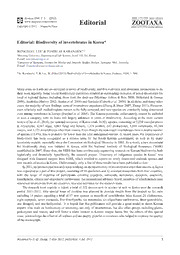
Editorial: Biodiversity of invertebrates in Korea PDF
Preview Editorial: Biodiversity of invertebrates in Korea
Zootaxa 3368: 5–6 (2012) ISSN 1175-5326 (print edition) www.mapress.com/zootaxa/ Editorial ZOOTAXA Copyright © 2012 · Magnolia Press ISSN1175-5334(online edition) Editorial: Biodiversity of invertebrates in Korea* WONCHOEL LEE1 & TOMISLAV KARANOVIC1, 2 1Hanyang University, Department of Life Science, Seoul 133-791, Korea E-mail: [email protected] 2University of Tasmania, Institute for Marine and Antarctic Studies, Hobart, Tasmania 7001, Australia E-mail: [email protected] *In: Karanovic, T. & Lee, W. (Eds) (2012) Biodiversity of Invertebrates in Korea. Zootaxa, 3368, 1–304. Many areas on Earth are un-surveyed in terms of biodiversity, and this motivates and stimulates taxonomists to do their work urgently. Some recent biodiversity endeavors resulted in outstanding examples of novel discoveries for local or regional faunas, including those from the deep-sea (Martínez Arbizu & Brix 2008; Brökeland & George 2009), Australia (Harvey 2002; Austin et al. 2008) and Sardinia (Cerretti et al. 2009). In all these, and many other cases, the majority of new findings were of invertebrate organisms (Zhang & Shear 2007; Zhang 2011). However, even relatively well studied regions remain to be fully surveyed, and new species are constantly being discovered even among vertebrates in Europe (Freyhof et al. 2005). The Korean peninsula, unfortunately, cannot be included in such a category, with its fauna still largely unknown in terms of biodiversity. According to the most current review (Cho et al., 2011), the national inventory of Korea totals 36,921 species, consisting of 5,230 vascular plants & bryophytes, 4,587 algae, 4,085 fungi and lichens, 1,374 protists, 647 prokaryotes, 1,841 vertebrates, 13,384 insects, and 5,773 invertebrates other than insects. Even though the non-insect invertebrates have a sizable number of species (15.4%), this is probably far lower than the total anticipated number. In recent years, the importance of biodiversity has been recognized as a serious issue by the South Korean government, as well as by many taxonomic experts, especially since the Convention on Biological Diversity in 1992. As a result, a new movement for biodiversity study was initiated in Korea, with the National Institute of Biological Resources (NIBR) established in 2007. Since then, the NIBR has been continuously supporting research on Korean biodiversity, both logistically and financially. Specifically, the research project ‘Discovery of indigenous species in Korea’ was designed with financial support from NIBR, which resulted in reports on newly discovered endemic species and new records of exotics in Korea. Unfortunately, only a few of these results have been published to date. In 2011, an international research team working on the biodiversity of invertebrates other than insects in Korea was organized as a part of this project, consisting of 18 specialists and 32 assistant researchers from four countries, with the range of expertise of participants covering copepods, ostracods, nematodes, decapods, arachnids, kinorhynchs, ciliates and oligochaete earthworms. An international advisory board, members of which include nine renowned taxonomists from six countries, was also activated for the research team. The research team expects to report a total of 322 species new to science or new to Korea over the research period 2011–2012. This special issue of Zootaxa was planned to provide results from the project so far, now including 14 papers reporting a total of 57 new species or records of invertebrates from Korea: 20 cladocerans, eight copepods, seven ostracods, five kinorhynchs, six nematodes, six oligochaete earthworms, three gastrotrichs, one decapod, and one bathynellid. It is hoped that this publication will provide a good model to direct Korean experts who work on biodiversity or taxonomy, not only of invertebrates, but also other groups including plants, prokaryotes and insects, and will foster a wider interest in Korean unique fauna. We, the editors of this special issue, acknowledge the effort of all authors and are deeply grateful to reviewers who helped to improve the quality of the manuscripts. Accepted by Z.-Q. Zhang: 3 May 2012; published: 4 Jul. 2012 5 References Austin, A., Cooper, S. & Humphreys, B. (2008) Preface to ‘Subterranean Connections: Biology and Evolution in Troglobiont and Groundwater Ecosystems’. Invertebrate Systematics, 22, iii. Brökeland, W. & George, K.H. (2009) Editorial: Deep-sea taxonomy—a contribution to our knowledge of biodiversity. Zootaxa, 2096, 6–8. Cerretti, P., Mason, F., Minelli, A., Nardi, G. & Whitemore, D. (2009) Editorial: Research on the terrestrial Arthropods of Sardinia (Italy). Zootaxa, 2318, 5–7. Cho, G. Y., Lee, J. S., Lee, J.-Y., Kim, B.-J., Nam, E. J., Eun, Y., Kim, T. W., Lee, B.-Y. & Oh, K.-H. (2011) The compilation of National List of indigenous species of the Korean Peninsula. Bulletin of National Institute of Biological Resources, 2, 1–6. Freyhof, J., Kottelat, M & Nolte, A. (2005) Taxonomic diversity of European Cottus with description of eight new species (Teleostei: Cottidae). Ichthyological Exploration of Freshwaters, 16, 107–172. Harvey, M. S. (2002) Forward to ‘Short-range Endemism in the Australian Biota’. Invertebrate Systematics, 16, iii. Martínez Arbizu, P. & Brix, S. (2008) Editorial: Bringing light into deep-sea biodiversity. Zootaxa, 1866, 5–6. Zhang, Z.-Q. & Shear, W. A. (2007) Linnaeus tercentenary and invertebrate taxonomy: an introduction. Zootaxa, 1668, 7–10. Zhang, Z.-Q. (2011) Animal Biodiversity: An introduction to higher-level classification and taxonomic richness. Zootaxa, 3148, 7–12. 6 · Zootaxa 3368 © 2012 Magnolia Press LEE & KARANOVIC
